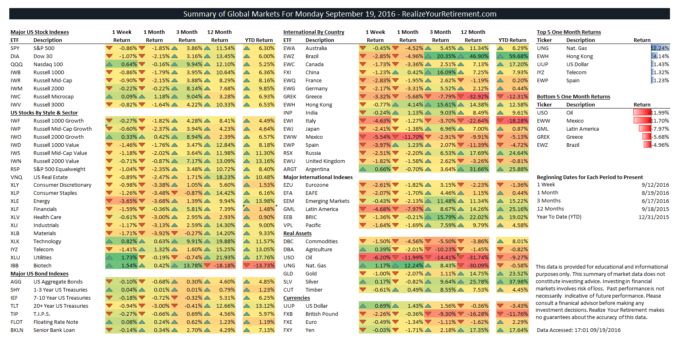Market Update – September 19, 2016
Current Conditions
The markets have finished down over the past week with the S&P 500 down -0.86%, the Dow Jones down -1.07%, international stocks (EAFE) down -2.07% and US Aggregate Bonds down -0.10%.
Asset Classes
Top asset classes for the past week include Utilities (1.73%), Biotech (1.54%), and Nat. Gas (1.17%).
Bottom asset classes for the past week include Oil (-6.2%), Mexico (-5.54%), and Latin America (-4.68%).
Top asset classes for the past month include Nat. Gas (12.24%), Hong Kong (4.14%), and US Dollar (1.43%).
Bottom asset classes for the past month include Oil (-11.99%), Mexico (-11.7%), and Latin America (-7.97%).
Economic Strength Index (ESI)
Updated on a monthly basis. (Chart may not display correctly via email.)
An ESI value of 32% indicates a:
Cautious Outlook
The ESI’s current value of 32% (down from 45%) indicates that the US economy is no longer in prime territory to support growth. While job numbers remain very strong and unemployment remains low several aspects of the US economy have begun to show their age in this market.
The ESI’s move to the low 30’s is a vote of caution. The economy is becoming more vulnerable to shocks. Should the ESI continue to maintain its low value or decline further, the likelihood of a recession will increase.
The levels of several indicators are still in fair territory (with a couple indicators in optimistic territory, mostly job numbers), while others are far below average. Year over year growth rates amongst the indicators underlying the ESI are in the 19th percentile (0 to 100 scale) down from the 21st percentile last month. This, combined with the current value of the ESI imply that we may see more softening of economic numbers to come.
Comments
Equity markets around the world had a shaky week due to concerns over the interest rates central banks, such as the Federal Reserve, intend to target.
US markets were mostly down this past week, with the Energy sector taking the largest hit with a 3.65% loss. However, the Utilities sector bounced back a bit with a 1.73% return over the past week, after having lagged other sectors in recent weeks.
The Financials sector saw a big rework over the past week as well. Real Estate holding companies are no longer included in the Financials sector and are now being classified as their own sector. So Financials index funds like XLF have seen reworks in their holdings, having dispensed of their real estate holdings within the fund.
International stocks were down, almost across the entire board, over the past week as well. Mexico (-5.54%), Italy (-4.63%), and Spain (-3.97%) were hit particularly hard, while more developed markets like Japan (-2.41%) and the UK (-1.82%) fell less far.
Bond classes were also hit again this week due to some renewed uncertainty about the Fed’s interest rate policies. The majority of bond asset classes were close to flat or down over the past week.
The Fed is set to meet on this Tuesday and Wednesday (September 20-21) to determine whether they will change interest rate policy for the US this quarter. The expectation is that interest rates will stay at their current target until at least December 2016. However, there is a (small) chance the Fed may increase its interest rate targets in an attempt to regain some of its lost credibility and to show that it is still in control of interest rate policy.
I’ll continue this refrain as long as we’re at the top of the markets. It’s easy to become over-allocated to stocks when markets are making new highs and the volatility of the last year is seemingly in the rear-view mirror. However, in times like these (when markets are reaching new highs) risk is at its greatest, so it’s important to maintain a balanced outlook in your portfolio.
When volatility increases, as it has in the past few weeks, it’s best to make small changes to your portfolio, with each change moving your portfolio to a more comfortable allocation. Large changes often lead to regret and poor market timing.


